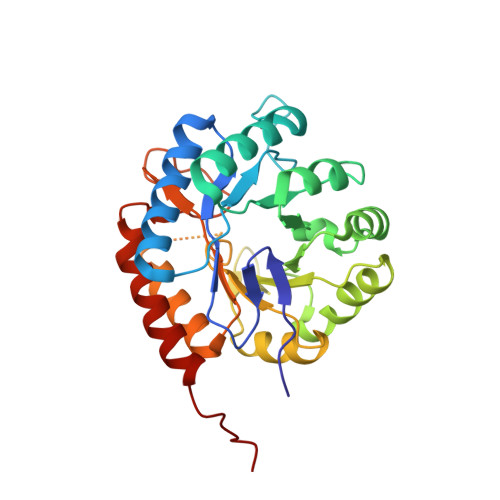Crystal Structures of Escherichia coli KDO8P Synthase Complexes Reveal the Source of Catalytic Irreversibility
Vainer, R., Belakhov, V., Rabkin, E., Baasov, T., Adir, N.(2005) J Mol Biology 351: 641-652
- PubMed: 16023668
- DOI: https://doi.org/10.1016/j.jmb.2005.06.021
- Primary Citation of Related Structures:
1PHW, 1Q3N, 1X6U, 1X8F - PubMed Abstract:
The enzyme 3-deoxy-D-manno-2-octulosonate-8-phosphate synthase (KDO8PS) catalyses the condensation of arabinose 5-phosphate (A5P) and phosphoenol pyruvate (PEP) to obtain 3-deoxy-D-manno-2-octulosonate-8-phosphate (KDO8P). We have elucidated initial modes of ligand binding in KDO8PS binary complexes by X-ray crystallography. Structures of the apo-enzyme and of binary complexes with the substrate PEP, the product KDO8P and the catalytically inactive 1-deoxy analog of arabinose 5-phosphate (1dA5P) were obtained. The KDO8PS active site resembles an irregular funnel with positive electrostatic potential situated at the bottom of the PEP-binding sub-site, which is the primary attractive force towards negatively charged phosphate moieties of all ligands. The structures of the ligand-free apo-KDO8PS and the binary complex with the product KDO8P visualize for the first time the role of His202 as an active-site gate. Examination of the crystal structures of KDO8PS with the KDO8P or 1dA5P shows these ligands bound to the enzyme in the PEP-binding sub-site, and not as expected to the A5P sub-site. Taken together, the structures presented here strengthen earlier evidence that this enzyme functions predominantly through positional catalysis, map out the roles of active-site residues and provide evidence that explains the total lack of catalytic reversibility.
- Department of Chemistry and Institute of Catalysis, Science and Technology, Technion-Israel Institute of Technology, Technion City, Haifa 32000, Israel.
Organizational Affiliation:

















